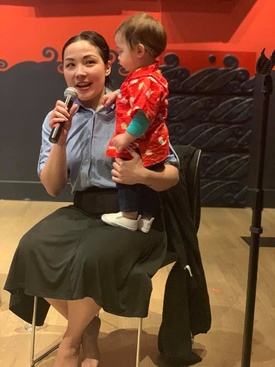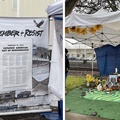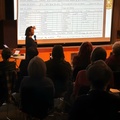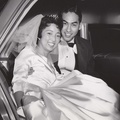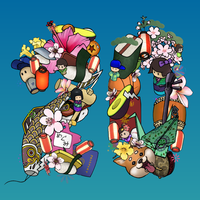In a heightened wave of anti-Asian racism, including attacks on Asian elders and the murders of 8 Asian women in Atlanta, I have felt the need to reach out—to family, to friends, to community. (For more about what’s been happening in the Seattle area, including a response from Yonsei professor Vince Schleitwiler, click here.)
I wanted to find out more about how we can learn from each other through working together, particularly in crossracial solidarity. As always, I found inspiration, solace, and comfort in doing so. I asked several Nikkei artists/activists in the Seattle area to respond to this moment, thinking about their own foundations for their current work. Here are three short interviews with several inspiring Seattle-area Nikkei women that I am proud to know.
* * * * *
Linda Ando: “Community is my family”
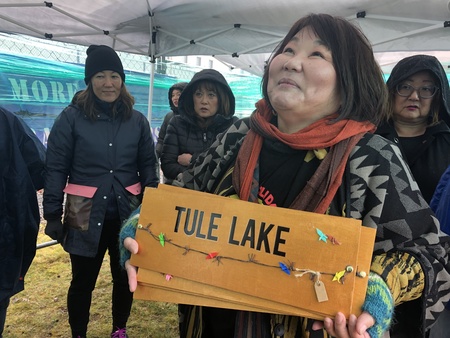
Linda Ando is a Sansei arts supporter, educator, activist, and artist. She is originally from Southern California and now living in Seattle, Washington. (These are edited notes from a Zoom conversation.)
Tamiko for Discover Nikkei: Where do you find inspiration or foundation for your work in crossracial solidarity? Who or what in your experience urged you towards crossracial solidarity, and how?
Linda: I think the foundation definitely first has to start with my family and my extended family, how I grew up in Southern California. Growing up and being raised in a multigenerational community. Community is my family. So, my grandparents with my cousins with farmer workers with other community people...sharing our home space like a community center. It starts there, with the imprint of my grandmother specifically having the vision to create a village of family compounds and using our space to farm, to host community centers....
And the inspiration has always been bearing witness, be it in person or through story-based or through lives lived, of injustices that people have gone through... And that has always left such an imprint in my life.
I’ve been raised with the consciousness of why we need to be involved....I really believe in what my job [serving the community through higher education] is. I really take it seriously. So when I “leave the job,” I don’t leave the job behind. It’s part of me, when I go into community or in the market, as an individual, as a person, it’s just who I am. I don’t separate out the two.
It’s not disembodied—I have to believe it. If I didn’t believe in it, I wouldn’t be able to do that work.
When you look at my age, because I am 60 ....I have enough lived life experiences to draw from. So I think my political awakening has been crossracial, has been political activism.
It really started early in my college years, came after living [and studying] abroad [in Japan for 3-4 years]... I was actually a commissioner for international students. International Students at that time included Palestinians, included Haitians...countries and peoples and histories I really didn’t know a lot about, which included complicated histories and injustices. When I returned [from Japan] to finish [my undergraduate studies] I became much more global—I became a global citizen. And my teachers were my friends from the different countries because I didn’t know what was happening. That’s where my activism really started.
[Then in the mid-1980s] I began working for Parks and Recreation supervisor] Dixie Swift and Homeland Cultural Center right in the middle of Long Beach [California]: a corridor where low-income immigrant communities lived, Khmer, Lao...and a lot of gang warfare between them. Dixie, who I loved, I worked as one of her community volunteer coordinators. She taught us how to bring peace and community together. She gave space [legal walls] to taggers, to those that were locked up in prison, to the families, space for the Khmer community....It was extraordinary to be mentored by someone Iike Dixie. Her father was a warden for the prison. So she knew what it was like to see what’s happening in the prison system. [Through the Homeland Cultural Center] I worked with librarians, community arts, history, artists. It was about giving respectfully, honoring communities so they’re not so isolated. There was bilingual storytelling, sharing food.
Then I came to know the nonprofit organization Children of War—Arn Chorn Pond. I was a supporter [of his work with youth]. He’s a survivor of the Khmer Rouge, inspirational—his music allowed him to survive.
[Later I met artist/musician] Nobuko Miyamoto with Great Leap, when I was at California State Long Beach. Hearing Nob’s story—the power of music, her story of being connected with the Black Panthers, a son who is biracial, her first husband who was murdered...so much richness in her music, her stories, and the lived histories, learning that Asians weren’t all silent. She introduced me to Yuri Kochiyama, and I had the good fortune to spend some time with Yuri.
Everybody is sort of like the network—it’s the personal connection, the personal stories.
Coming to Seattle, I’ve been involved with Artists for Japan (for Tohoku), to Tsuru for Solidarity, being really active with healing circles, with Satsuki [Ina], La Resistencia, Tule Lake [Committee]...Bearing witness and hearing not just the facts but the emotions and the damages done and the need for healing.
Other critical things—[I’ve been] working at the [University of Washington] with colleagues with intergroup dialogues with a social justice perspective. Right now [at the University] I am doing a lot with Cultivating a Culture of Care initiative,—mental and health and awareness for Asian American and Native Hawaiian and Pacific Islander students.
Where would you suggest we direct our current and future efforts in crossracial solidarity as Nikkei? Where do you hope the Nikkei community can direct our energies?
Linda: I think learning about how other groups in the past have done things. There’s a lot for us to learn, like the Black Panthers, they did teach-ins, Feed the Children....[We can] build more community dialogues and community dinners [with] peoples of all different ages and races. [We can] work together on local and community projects, like garden centers, health, arts. The more people have a chance to hear each other’s stories, the better.
* * * * *
Erin Shigaki: “I want us to be loud”
Erin Shigaki is a Yonsei born and raised in Seattle, WA. While not formally trained in any single artistic practice, she considers her mother’s and grandparents’ artistic interests and encouragement to be foundational to her curiosity and exploration. In her social justice practice, she infuses community stories into murals, sculpture, and installations. Erin is also a community activist with the Minidoka Pilgrimage, Tsuru for Solidarity, and serves on the board of the TV program Look Listen + Learn. All of this work is fundamental to her artistic practice. Find out more about Erin at her website, Purple Gate Design www.purplegatedesign.com
Tamiko: Where do you find inspiration or foundation for your work in crossracial solidarity? Who or what in your experience urged you towards crossracial solidarity, and how?
Erin: I’m inspired by spending so much of my childhood in Seattle’s Central Area where my Grandma and Grandpa Shigaki owned a home. In the time of redlining, it was a neighborhood where Black, Indigenous, and people of color could buy homes. Communities flourished together there—in the shops, in the schools, on the sports fields. I also think about my time at Franklin High School which, due to mandatory busing, was about ⅓ Black, a ⅓ Asian and ⅓ white. I had the best social education, despite being naive enough to think that we reflected Seattle’s make-up. When I next landed in the extremely white and privileged setting of Yale, we kids of color found each other, found ethnic studies, and I started to find my voice in crossracial solidarity movements.
Tamiko: What kinds of histories or stories do we need in our current searches for crossracial solidarity?
Erin: So many of of our solidarity stories have been erased by the supremacist machine that was designed to keep us apart. Nikkei active in the liberation movement have always known what we owe to our Black siblings and the Civil Rights Movement of the 1960s. And we were also there, awakening and demanding that African Americans have equal access to voting, housing, education, employment, and public accommodations. I also think that individual crossracial relationships make meaningful change and can powerfully divert us from stereotypes and misunderstandings about the other.
Tamiko: Where would you suggest we direct our current and future efforts in crossracial solidarity as Nikkei?
Erin: My wish for Nikkei is that we not only remember and tell what our people went through during WWII, but that we also understand how our incarceration is entwined in the history of white supremacy in the U.S. I want us to be loud in the liberation movement to end mass incarceration and abolish the current police state — never silenced, never erased. I want us to support reparations for Black people because we know that our own reparations brought healing and reassurance that our faith in the American dream of belonging was not in vain.
* * * * *
Gabrielle Kazuko Nomura Gainor: “I’m in it for the liberation of all beings”
Gabrielle Kazuko Nomura Gainor (she/her) tells stories about Asian America through dance. The Japanese/Filipinx/Irish American has received grants from Seattle’s Office of Arts & Culture and the Washington State Arts Commission. A dancer, choreographer, and community activist, Gabrielle also works for Seattle Opera in communications and public engagement. Learn more at gabriellekazuko.com
Tamiko: Where do you find inspiration or foundation for your work in crossracial solidarity? Who or what in your experience urged you towards crossracial solidarity, and how?
Gabrielle: The foundation of my work in crossracial solidarity is my own experience of growing up “other.”
A woman of Filipinx, Japanese, and white heritage, I have always been acutely aware of my “other-ness.” There were few places for me to rest in the comfort of being “just like everyone else.” From being taunted with “Chinese, Japanese, Dirty Knees” in elementary school, to being the one Filipina in my family, I understood what it felt like to not belong, and how deeply unsettling that felt in my body as a child.
My experience with racial justice work is that it’s like falling down a rabbit hole: When I came to deeply know the oppression that Japanese Americans have experienced, how could my heart not be opened to the pain of families crossing borders, fleeing for their lives in search of safety and human dignity? How could my caring stop at the threshold of Asian oppression when my family was still able to immigrate to this country of their own free will (unlike enslaved Black people)?
Therefore, it’s not possible for my love, my longing for justice, my rage, and my action to remain in the sole interest of Asian America. My allegiance is not simply with Asians. My allegiance is with Black folks. With Indigenous folks. With Latinx folks. My allegiance is with those who are still waiting to be free. While I am an Asian American activist, I strive to be a person who places those most harmed by white supremacy at the center of my anti-racist thought and action. And as a Buddhist, I’m in it for the liberation of all beings—not simply the ones I share a culture with. Not simply the ones who look like me, or my aunties, or my grandparents.
When we as Nikkei prioritize our own interests yet turn a blind eye to the suffering of others, we are taking the bait of model minority status. When our “Stop Asian Hate” efforts call for an increase in policing that endangers our Black siblings, we’re throwing other people under the bus for our own safety. When we speak out against affirmative action and prioritize our own people in higher-education settings, we send the message that Asian representation is important but the representation of our BIPOC siblings is not a priority. If we truly believe that “Never Again is Now” then won't our voices also ring out—loud and clear—that “Black Lives Matter”?!
Tamiko: What kinds of histories or stories do we need in our current searches for crossracial solidarity?
Gabrielle: The women who shared the following quotes are the type of people who inspire me. We’ve spent a lot of time talking about the courageous Nikkei men who stood up for our rights during WW2. I am interested in intersectional stories, stories of radical Asian American women, including queer and trans women, who have worked arm-and-arm with our Black and Brown siblings for our collective liberation.
“I came to realize that our internment was a trifle compared to the two hundred years or so of enslavement and prejudice that others in this county were heir to.”
—Hisaye Yamamoto, acclaimed Nisei author
“The United States of America is a nation where people are not united because of those three glaring frailties: racism, injustices, and inequities.”
—Yuri Kochiyama, iconic Japanese American civil rights and anti-war activist
“The fate of each minority depends upon the extent of justice given all other groups.”
—Ina Sugihara, Nisei activist
Tamiko: Where would you suggest we direct our current and future efforts in crossracial solidarity as Nikkei?
Gabrielle: All People of Color come from distinct communities. However, I would encourage my fellow Nikkei to think about this more from a place of antiracism, and less from a place of crossracial solidarity. To me, crossracial solidarity implies that People of Color are playing to win for our own teams. In reality, our fates are tied up, our pain rooted in a common oppressive system: white supremacy. When we can zoom way out, when we can commit to truly seeing the entirety of the rigged system, we WILL be better accomplices for Black liberation. We will also be more powerful advocates for ourselves, whether we’re speaking to the lasting trauma of wartime incarceration, or the hatred, violence, and attacks we face now.
With the deepest of love and respect, I invite my fellow Nikkei to compare and contrast our American origin stories of immigration to that of genoicde and enslavement. This is not about playing “oppression olympics” with Indigenous folks or Black folks. It’s about understanding our own place in a country whose prosperity is built on stolen land and stolen labor; a country that has relied on unthinkable violence and acts against humanity to become “number-one.” We as Japanese Americans must fully understand how we are harmed by the rigged system, and also, how we benefit. We have to understand how and why our country is harmful in order to remove the danger, and ultimately to help with the healing.
Please read Black authors, follow the work of Black and Indigenous community leaders, and show up with your protest signs—not only when our own community is in danger—but when our BIPOC siblings are crying out for support, as well.
I’d love to have you all at an upcoming event that Seattle JACL is presenting. As part of our Uprooting Anti-Blackness Series, we’re hosting Dr. Ayanna Yonemura, a brilliant Black/Nikkei scholar at 2 p.m. on Saturday, April 17. More details on the Seattle JACL Facebook page.
© 2021 Tamiko Nimura



